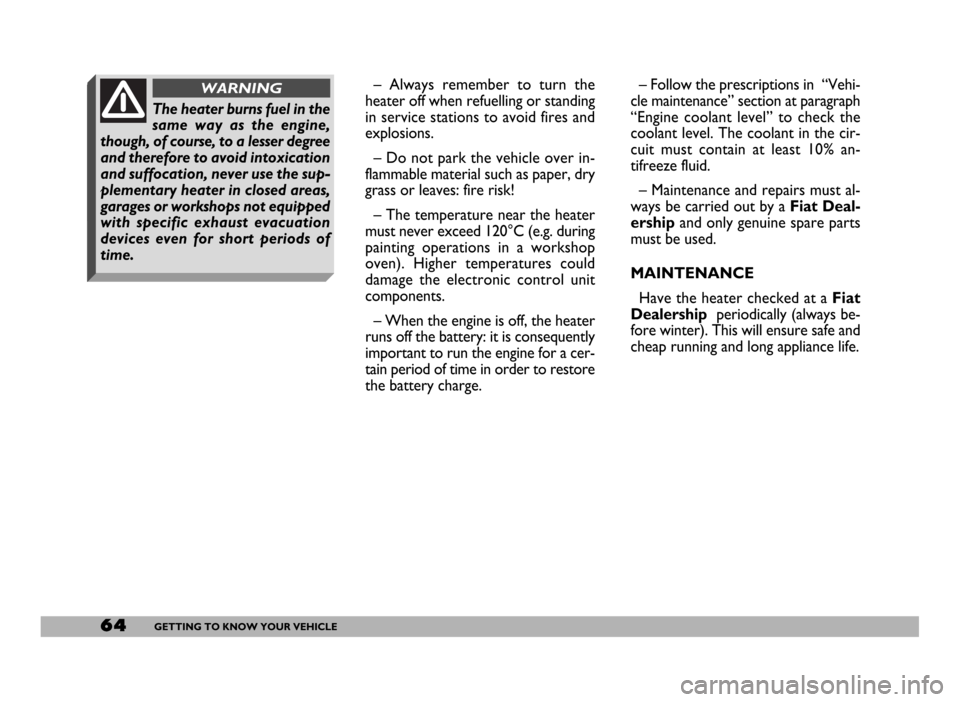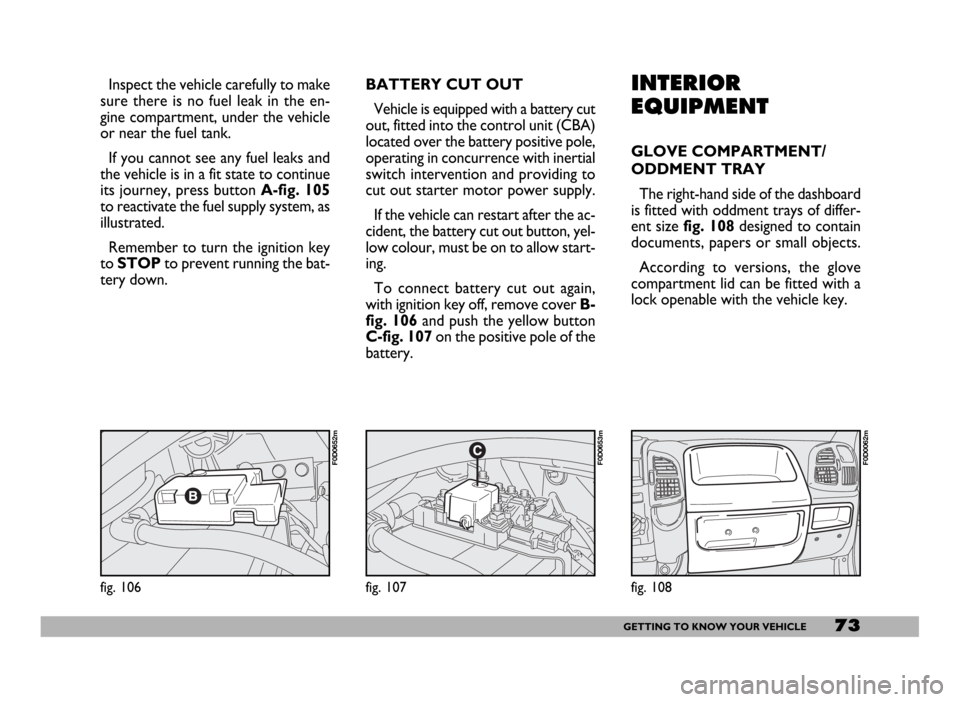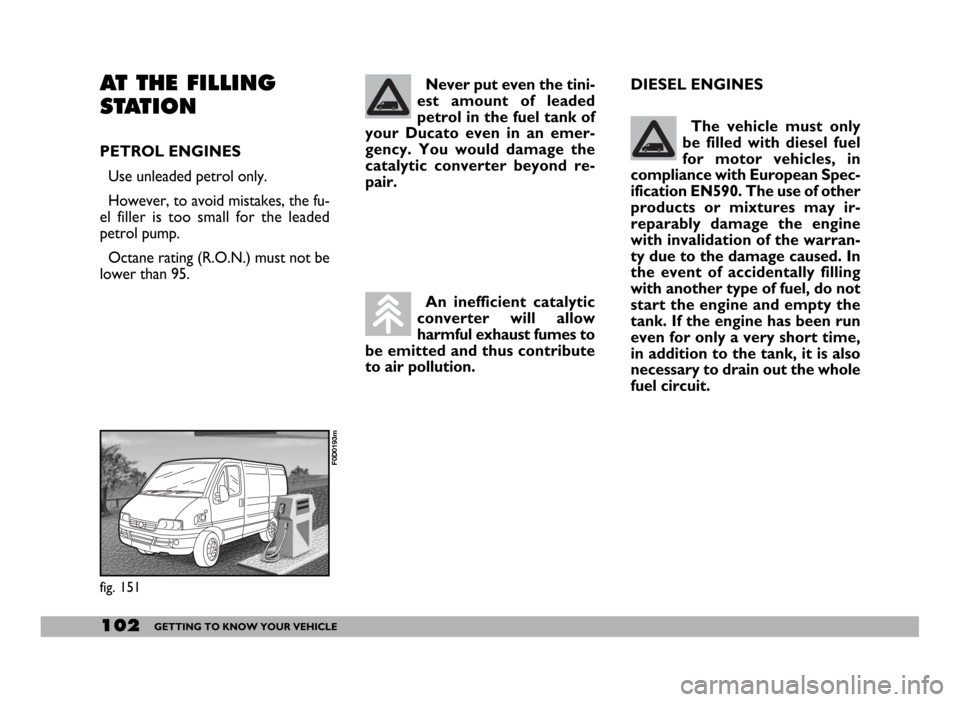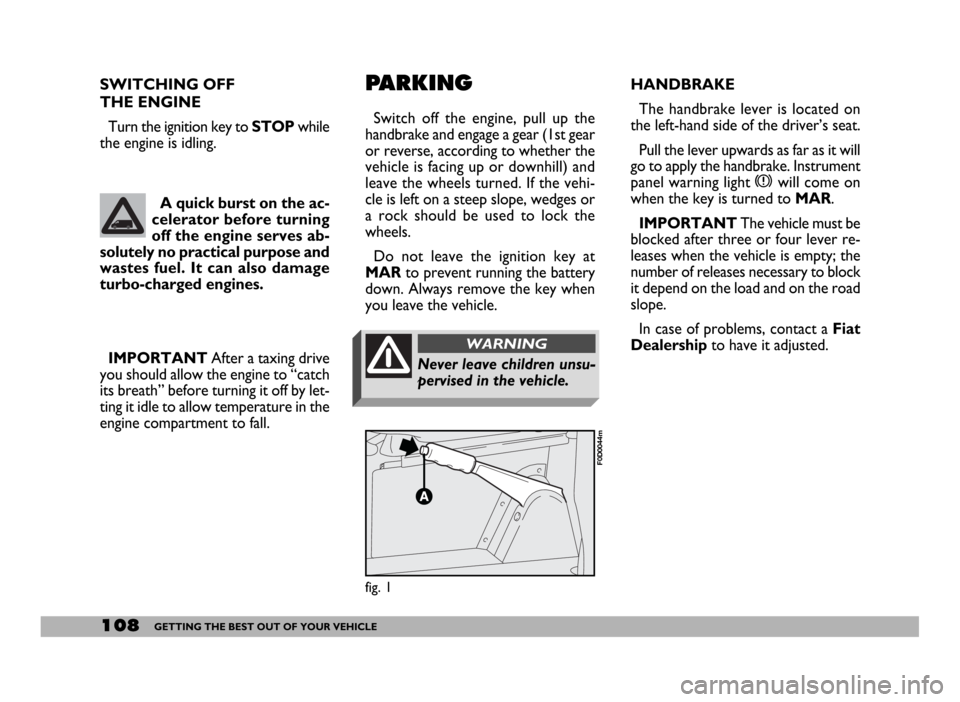Page 65 of 258

64GETTING TO KNOW YOUR VEHICLE
– Always remember to turn the
heater off when refuelling or standing
in service stations to avoid fires and
explosions.
– Do not park the vehicle over in-
flammable material such as paper, dry
grass or leaves: fire risk!
– The temperature near the heater
must never exceed 120°C (e.g. during
painting operations in a workshop
oven). Higher temperatures could
damage the electronic control unit
components.
– When the engine is off, the heater
runs off the battery: it is consequently
important to run the engine for a cer-
tain period of time in order to restore
the battery charge.– Follow the prescriptions in “Vehi-
cle maintenance” section at paragraph
“Engine coolant level” to check the
coolant level. The coolant in the cir-
cuit must contain at least 10% an-
tifreeze fluid.
– Maintenance and repairs must al-
ways be carried out by a Fiat Deal-
ershipand only genuine spare parts
must be used.
MAINTENANCE
Have the heater checked at a Fiat
Dealership periodically (always be-
fore winter). This will ensure safe and
cheap running and long appliance life.
The heater burns fuel in the
same way as the engine,
though, of course, to a lesser degree
and therefore to avoid intoxication
and suffocation, never use the sup-
plementary heater in closed areas,
garages or workshops not equipped
with specific exhaust evacuation
devices even for short periods of
time.
WARNING
Page 73 of 258
72GETTING TO KNOW YOUR VEHICLE
fig. 104
F0D00164m
fig. 105
F0D105m
All direction indicators will flash and
the instrument panel warning lights r
and ycome on when the button is
pressed regardless of the ignition key
position.FUEL CUT-OFF SWITCH
This a safety cut-off switch located in
the engine compartment on the dash-
board bulkhead fig. 105which comes
into operation in the case of an acci-
dent to block the supply of fuel there-
by stopping the engine.
D- Rear fog lights on/off.
E- ASR system (Antislip Regulation)
on/off.LEFT-HAND BUTTON
PANEL
Button panel in fig. 104is used on
Minibus, Ambulance and 4WD ver-
sions for adding special optional equip-
ment.
The use of hazard lights is
governed by the Highway
Code of the country you are in.
Keep to the rules.
WARNING
If, after an accident, you
can smell petrol or see that
the fuel feed system is leaking, to
avoid the risk of fire, do not reset
the switch.
WARNING
Page 74 of 258

73GETTING TO KNOW YOUR VEHICLE
Inspect the vehicle carefully to make
sure there is no fuel leak in the en-
gine compartment, under the vehicle
or near the fuel tank.
If you cannot see any fuel leaks and
the vehicle is in a fit state to continue
its journey, press button A-fig. 105
to reactivate the fuel supply system, as
illustrated.
Remember to turn the ignition key
to STOPto prevent running the bat-
tery down.INTERIOR
EQUIPMENT
GLOVE COMPARTMENT/
ODDMENT TRAY
The right-hand side of the dashboard
is fitted with oddment trays of differ-
ent sizefig. 108designed to contain
documents, papers or small objects.
According to versions, the glove
compartment lid can be fitted with a
lock openable with the vehicle key.
fig. 108
F0D0062m
fig. 106
F0D0652m
fig. 107
F0D0653m
BATTERY CUT OUT
Vehicle is equipped with a battery cut
out, fitted into the control unit (CBA)
located over the battery positive pole,
operating in concurrence with inertial
switch intervention and providing to
cut out starter motor power supply.
If the vehicle can restart after the ac-
cident, the battery cut out button, yel-
low colour, must be on to allow start-
ing.
To connect battery cut out again,
with ignition key off, remove cover B-
fig. 106 and push the yellow button
C-fig. 107 on the positive pole of the
battery.
Page 103 of 258

102GETTING TO KNOW YOUR VEHICLE
DIESEL ENGINES
The vehicle must only
be filled with diesel fuel
for motor vehicles, in
compliance with European Spec-
ification EN590. The use of other
products or mixtures may ir-
reparably damage the engine
with invalidation of the warran-
ty due to the damage caused. In
the event of accidentally filling
with another type of fuel, do not
start the engine and empty the
tank. If the engine has been run
even for only a very short time,
in addition to the tank, it is also
necessary to drain out the whole
fuel circuit.AT THE FILLING
STATION
PETROL ENGINES
Use unleaded petrol only.
However, to avoid mistakes, the fu-
el filler is too small for the leaded
petrol pump.
Octane rating (R.O.N.) must not be
lower than 95.
fig. 151
F0D0193m
Never put even the tini-
est amount of leaded
petrol in the fuel tank of
your Ducato even in an emer-
gency. You would damage the
catalytic converter beyond re-
pair.
An inefficient catalytic
converter will allow
harmful exhaust fumes to
be emitted and thus contribute
to air pollution.
Page 104 of 258
103GETTING TO KNOW YOUR VEHICLE
FUEL FILLER CAP
The fuel filler cap C-fig. 153is fitted
with a key lock and a device Bsecur-
ing it to the lid Aso that it cannot be
lost.
Open lid A-fig. 152pressing where
indicated by the arrow to get to the
fuel filler cap.
When refuelling, position the cap on
the flap as shown in fig. 153.
fig. 152
F0D0139m
Diesel fuel fluidity decreases at low
temperatures due to the paraffin it
contains and can clog up the fuel filter.
To avoid possible problems, fuelling
stations usually sell summer, winter or
arctic (mountain/cold areas) fuel ac-
cording to the period of the year. If refuelling with diesel fuel not suitable
for the temperature of use, add
DIESEL MIXto the fuel, in the pro-
portions written on the container. Pour
the antifreeze into the fuel tank before
the fuel.
DIESEL MIXantifreeze is effective
only if it is added before the cold be-
gins to take effect on the fuel. Adding
the product after will not have any ef-
fect.
Page 105 of 258

104GETTING TO KNOW YOUR VEHICLE
IMPORTANTThe airtight seal of
the cap may lead to a slight increase of
pressure in the tank. A hissing sound
when the cap is removed is therefore
quite normal.
After refuelling, screw the cap until
hearing one or more clicks, turn the
key and then remove it.. close the lid.
IMPORTANTMoreover, before
starting the engine, for the sake of
safety, check whether the refuelling
gun is properly hung onto the fuel
pump.If required, replace the
fuel cap with another gen-
uine cap to avoid affecting
the efficiency of the fuel vapour
recovery system.
fig. 153
F0D0140m
PROTECTING THE
ENVIRONMENT
Protection of the environment has
been the guiding principle in the design
of the Fiat Ducato right from the start.
The result is the use of materials and
creation of devices that can reduce or
considerably curtail harmful influences
on the environment.
The devices for curtailing petrol en-
gine emissions are:
– a three-way catalytic converter;
– a lambda sensor;
– a fuel evaporation system.
The devices for curtailing diesel en-
gine emissions are:
– an oxidising catalytic converter;
– an exhaust gas recirculation system
(E.G.R.) (for certain versions).
Consequently, the Fiat Ducato is
ready to travel well ahead of the most
stringent international pollution control
standards.
Keep naked flames or light-
ed cigarettes away from
the fuel filler hole as there is a dan-
ger of fire. Do not bend too close to
the hole either so as not to breathe
in harmful vapours.
WARNING
Page 108 of 258

107GETTING THE BEST OUT OF YOUR VEHICLE
If you still cannot start the engine,
get in touch with a Fiat Dealership.
IMPORTANT When the outside
temperature is low, it is important to
note that the use of a more fluid oil
will facilitate starting the cold engine.
Therefore, in winter, follow the advice
in chapter “Technical specifications”,
paragraph “Fluids and lubricants”.
IMPORTANTNever leave the igni-
tion key at MARwhen the engine is off.
Minibus and School Bus versions:
press the ignition enable button lo-
cated to the left of the steering col-
umn as shown in the specific supple-
ment to this handbook.HOW TO WARM UP
THE ENGINE AFTER IT
HAS JUST STARTED
(petrol and diesel versions)
– Begin to move forward slowly let-
ting the engine turn at medium revs.
Do not accelerate abruptly.
– Do not push the engine to its lim-
it for the first few kilometres. You are
recommended to wait until the
coolant temperature indicator starts
to move.
EMERGENCY START-UP
If the Fiat CODE system fails to
recognise that code transmitted by the
ignition key (warning light Yon the
instrument panel lit) the emergency
start-up can be performed by using the
CODE card code.
See the “In an emergency” section.Catalysed vehicles must
not be bump started
(pushed, towed or coast-
ed downhill) as this could cause
fuel to flow into the catalytic ex-
haust system and damage it be-
yond repair.
Remember that until the
engine has started the
brake booster and power steering
systems will not work and a greater
effort will therefore be required to
depress the brake pedal or turn the
steering wheel.
WARNING
Page 109 of 258

108GETTING THE BEST OUT OF YOUR VEHICLE
SWITCHING OFF
THE ENGINE
Turn the ignition key to STOPwhile
the engine is idling.
IMPORTANTAfter a taxing drive
you should allow the engine to “catch
its breath” before turning it off by let-
ting it idle to allow temperature in the
engine compartment to fall.PARKING
Switch off the engine, pull up the
handbrake and engage a gear (1st gear
or reverse, according to whether the
vehicle is facing up or downhill) and
leave the wheels turned. If the vehi-
cle is left on a steep slope, wedges or
a rock should be used to lock the
wheels.
Do not leave the ignition key at
MAR to prevent running the battery
down. Always remove the key when
you leave the vehicle.HANDBRAKE
The handbrake lever is located on
the left-hand side of the driver’s seat.
Pull the lever upwards as far as it will
go to apply the handbrake. Instrument
panel warning light xwill come on
when the key is turned to MAR.
IMPORTANTThe vehicle must be
blocked after three or four lever re-
leases when the vehicle is empty; the
number of releases necessary to block
it depend on the load and on the road
slope.
In case of problems, contact a Fiat
Dealershipto have it adjusted. A quick burst on the ac-
celerator before turning
off the engine serves ab-
solutely no practical purpose and
wastes fuel. It can also damage
turbo-charged engines.
fig. 1
F0D0044m
Never leave children unsu-
pervised in the vehicle.
WARNING